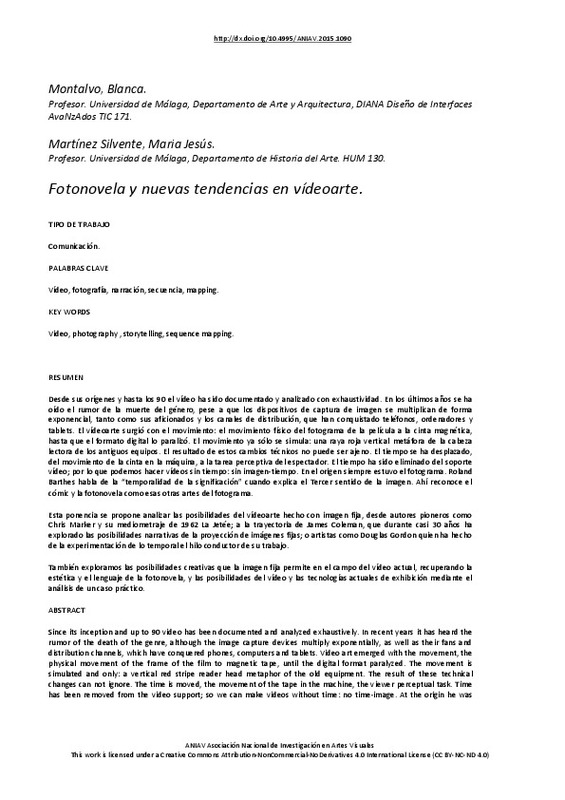JavaScript is disabled for your browser. Some features of this site may not work without it.
Buscar en RiuNet
Listar
Mi cuenta
Estadísticas
Ayuda RiuNet
Admin. UPV
FOTONOVELA Y NUEVAS TENDENCIAS EN VÍDEO ARTE
Mostrar el registro sencillo del ítem
Ficheros en el ítem
| dc.contributor.author | Montalvo Gallego, Blanca
|
es_ES |
| dc.contributor.author | Martínez Silvente, María
|
es_ES |
| dc.date.accessioned | 2017-10-16T09:44:21Z | |
| dc.date.available | 2017-10-16T09:44:21Z | |
| dc.date.issued | 2015-11-26 | |
| dc.identifier.isbn | 9788490483411 | |
| dc.identifier.uri | http://hdl.handle.net/10251/89177 | |
| dc.description.abstract | [EN] Since its inception and up to 90 video has been documented and analyzed exhaustively. In recent years it has heard the rumor of the death of the genre, although the image capture devices multiply exponentially, as well as their fans and distribution channels, which have conquered phones, computers and tablets. Video art emerged with the movement, the physical movement of the frame of the film to magnetic tape, until the digital format paralyzed. The movement is simulated and only: a vertical red stripe reader head metaphor of the old equipment. The result of these technical changes can not ignore. The time is moved, the movement of the tape in the machine, the viewer perceptual task. Time has been removed from the video support; so we can make videos without time: no time--‐image. At the origin he was always the frame. Roland Barthes speaks of "temporality of meaning" when explaining the third sense of the image. He recognizes there fotonovela comics and other arts like that frame. This paper attempts to analyze the possibilities of video art still image made from pioneering authors like Chris Marker and his 1962 short film La Jetée; to the path of James Coleman, who for nearly 30 years has explored the narrative possibilities of the projection of still images; or artists such as Douglas Gordon who has made the temporal experimentation the theme of his work. We also explored the creative possibilities that allows the still image in the current video field, recovering the aesthetics and language of fotonovela, and possibilities of current video and display technologies through the analysis of a case study. | es_ES |
| dc.description.abstract | [ES] Desde sus orígenes y hasta los 90 el vídeo ha sido documentado y analizado con exhaustividad. En los últimos años se ha oído el rumor de la muerte del género, pese a que los dispositivos de captura de imagen se multiplican de forma exponencial, tanto como sus aficionados y los canales de distribución, que han conquistado teléfonos, ordenadores y tablets. El vídeoarte surgió con el movimiento: el movimiento físico del fotograma de la película a la cinta magnética, hasta que el formato digital lo paralizó. El movimiento ya sólo se simula: una raya roja vertical metáfora de la cabeza lectora de los antiguos equipos. El resultado de estos cambios técnicos no puede ser ajeno. El tiempo se ha desplazado, del movimiento de la cinta en la máquina, a la tarea perceptiva del espectador. El tiempo ha sido eliminado del soporte vídeo; por lo que podemos hacer vídeos sin tiempo: sin imagen-tiempo. En el origen siempre estuvo el fotograma. Roland Barthes habla de la “temporalidad de la significación” cuando explica el Tercer sentido de la imagen. Ahí reconoce el cómic y la fotonovela como esas otras artes del fotograma. Esta ponencia se propone analizar las posibilidades del vídeoarte hecho con imagen fija, desde autores pioneros como Chris Marker y su mediometraje de 1962 La Jetée; a la trayectoria de James Coleman, que durante casi 30 años ha explorado las posibilidades narrativas de la proyección de imágenes fijas; o artistas como Douglas Gordon quien ha hecho de la exploración de lo temporal el hilo conductor de su trabajo. También exploramos las posibilidades creativas que la imagen fija permite en el campo del vídeo actual, recuperando la estética y el lenguaje de la fotonovela, y las posibilidades del vídeo y las tecnologías actuales de exhibición mediante el análisis de un caso práctico. | es_ES |
| dc.format.extent | 8 | es_ES |
| dc.language | Español | es_ES |
| dc.publisher | Editorial Universitat Politècnica de València | es_ES |
| dc.relation.ispartof | II CONGRESO INTERNACIONAL DE INVESTIGACIÓN DE ARTES VISUALES | es_ES |
| dc.rights | Reconocimiento - No comercial - Sin obra derivada (by-nc-nd) | es_ES |
| dc.subject | Arte | es_ES |
| dc.subject | Producción artística | es_ES |
| dc.subject | Estética | es_ES |
| dc.subject | Teoría del arte | es_ES |
| dc.subject | Gestión cultural | es_ES |
| dc.subject | Educación artística | es_ES |
| dc.subject | Investigación artística | es_ES |
| dc.title | FOTONOVELA Y NUEVAS TENDENCIAS EN VÍDEO ARTE | es_ES |
| dc.type | Capítulo de libro | es_ES |
| dc.type | Comunicación en congreso | es_ES |
| dc.identifier.doi | 10.4995/ANIAV2015.1090 | |
| dc.rights.accessRights | Abierto | es_ES |
| dc.description.bibliographicCitation | Montalvo Gallego, B.; Martínez Silvente, M. (2015). FOTONOVELA Y NUEVAS TENDENCIAS EN VÍDEO ARTE. En II CONGRESO INTERNACIONAL DE INVESTIGACIÓN DE ARTES VISUALES. Editorial Universitat Politècnica de València. 537-545. https://doi.org/10.4995/ANIAV2015.1090 | es_ES |
| dc.description.accrualMethod | OCS | es_ES |
| dc.relation.conferencename | II Congreso Internacional de Investigación en Artes Visuales. |< real | virtual >| ANIAV2015 | es_ES |
| dc.relation.conferencedate | July 09-10,2015 | es_ES |
| dc.relation.conferenceplace | Valencia, Spain | es_ES |
| dc.relation.publisherversion | http://ocs.editorial.upv.es/index.php/ANIAV/ANIAV2015/paper/view/1090 | es_ES |
| dc.description.upvformatpinicio | 537 | es_ES |
| dc.description.upvformatpfin | 545 | es_ES |
| dc.type.version | info:eu-repo/semantics/publishedVersion | es_ES |
| dc.relation.pasarela | OCS\1090 | es_ES |








